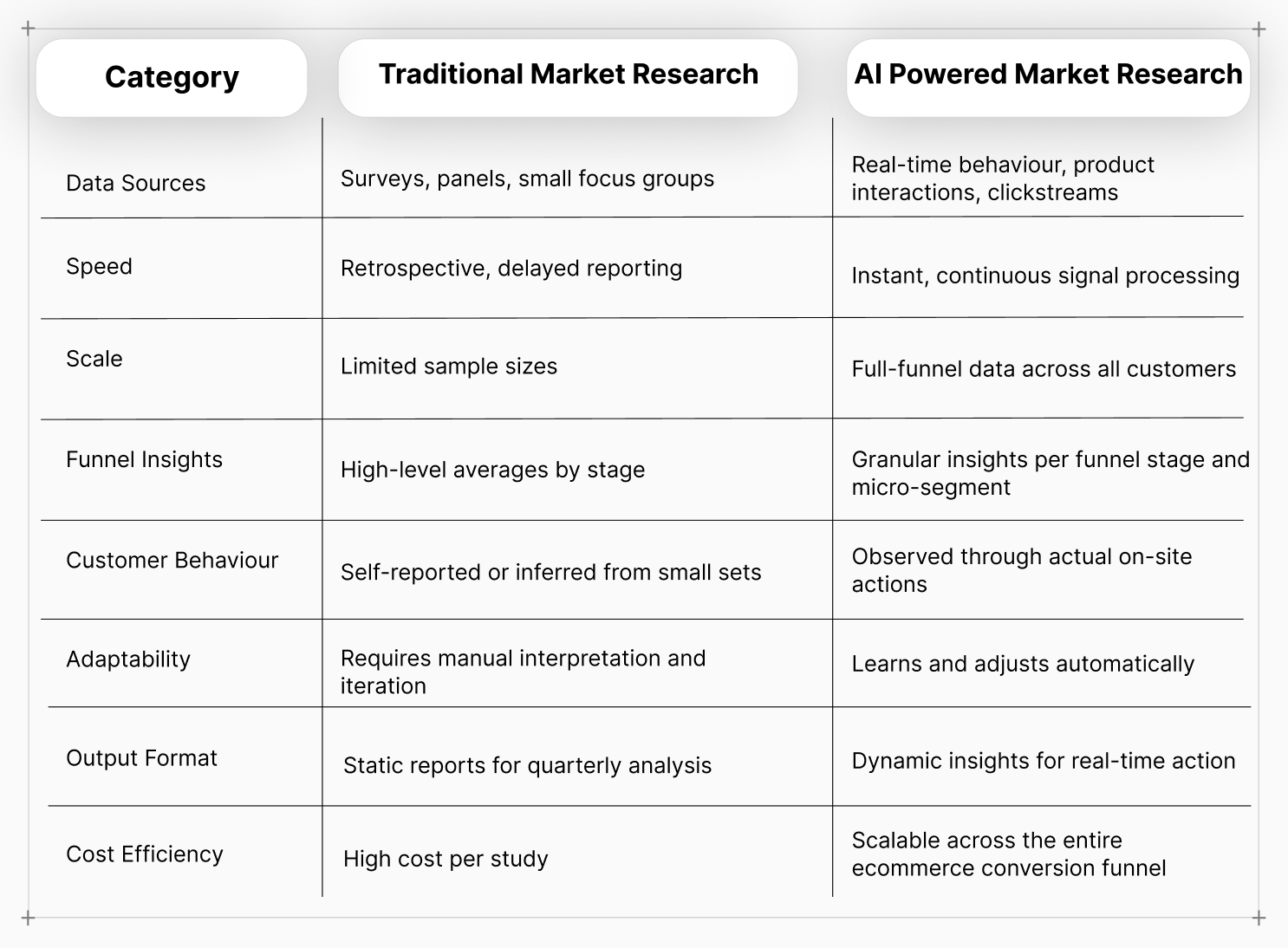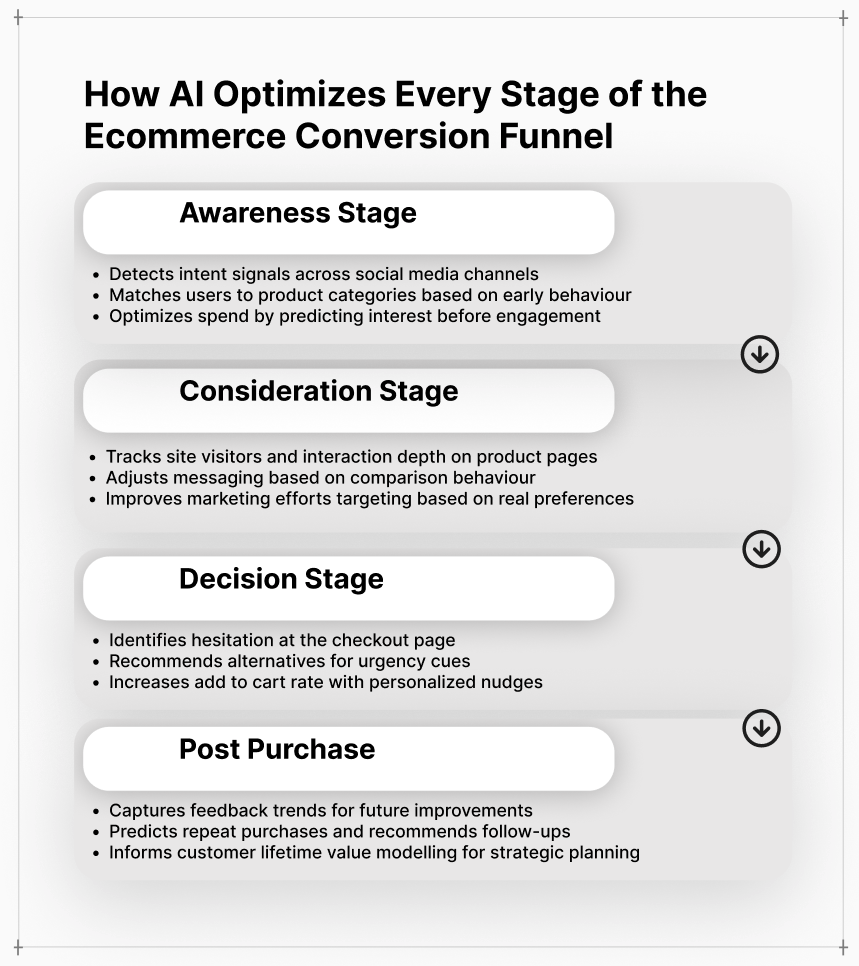Key Takeaways





Key Takeaways




Behaviour Doesn’t Always Speak in Words.
Most customer journeys do not begin with a question. They begin with a pause.
A skipped ad. A quick scroll. A product page opened without action. These moments often go unnoticed, yet they carry meaning that traditional tools cannot capture.
Customer behavior now unfolds across different channels, devices, and formats. Attention moves quickly. Preferences shift. The ecommerce conversion funnel becomes harder to track with conventional methods.
Old research models rely on direct input. The modern customer rarely offers it.
AI-powered market research provides an alternative. It processes digital signals as they happen. It detects interest, hesitation, and response patterns that surveys cannot reach.
A low add to cart rate or an abandoned checkout page can indicate friction. These are not gaps in the data. They are markers of intent, waiting to be understood.
This article examines how GenAI turns behavioural input into actionable insight. It explains how ecommerce teams can interpret the customer journey with greater speed and accuracy using real-time market intelligence.
AI-powered market research is a method of extracting insights from large and often unstructured data sources using machine learning and natural language processing.
Unlike traditional approaches that depend on direct feedback, this technique identifies patterns in real-time customer interactions.
It captures signals across the ecommerce conversion funnel, including activity on product pages, drop-offs at the checkout page, and engagement with social media channels. These signals reveal what customers care about, how they navigate the customer journey, and where friction occurs.

Rather than asking what customers think, this approach observes what they do. It interprets behaviors such as:
These data points are not isolated. Together, they help identify issues at different funnel stages and guide improvements that increase conversion rate.
By continuously analyzing behavior, AI-powered market research helps ecommerce businesses stay aligned with shifting expectations.
The next step is to understand how this technology influences decision-making throughout the entire customer journey.
Modern customer journeys are not linear. A single decision path may span several visits, devices, and touchpoints. Customers explore product pages, abandon carts, revisit links from social media channels, or return days later to complete a purchase. Tracking this behavior manually is no longer practical.
AI detects and connects fragmented behavior across the ecommerce conversion funnel. It identifies where site visitors hesitate, where customers lose interest, and what leads to a completed checkout. This supports more accurate targeting and better allocation of marketing efforts.
By analyzing each funnel stage, AI highlights:
It becomes possible to tie real actions to intent, even when no direct input is provided. This clarity helps teams identify what affects conversion funnel performance at scale.
AI tools such as GenAI add predictive power. They can anticipate product interest, detect segment shifts, and optimize the timing of messages across the ecommerce marketing funnel.
When each interaction is interpreted in context, businesses gain a clearer view of their actual buyer’s journey.
This intelligence enables more relevant experiences and stronger funnel performance. But the value goes beyond insight. The next section explores how this translates into practical advantages for ecommerce teams.
AI-powered market research helps ecommerce teams improve performance at every level of the conversion funnel. It does more than describe behavior. It helps businesses respond to it with speed and accuracy.

AI surfaces patterns that manual analysis misses. It identifies where potential customers disengage and where repeat purchases occur most often.
This makes it easier to adjust campaigns, refine content, and improve navigation based on what customers actually do.
By monitoring behavior as it happens, AI enables teams to improve conversion rate without relying on static reports.
With deeper insight, campaigns become more efficient. AI reduces irrelevant targeting and helps guide marketing efforts toward the right target audience.
AI helps teams understand what affects customer lifetime value. It improves planning by predicting outcomes based on actual performance, not assumptions.
These benefits are shaping a new standard for ecommerce. But every system has limits.
While AI-powered market research offers clear advantages, several obstacles can limit its effectiveness. These challenges must be addressed to ensure reliable outcomes and sustainable impact across the ecommerce conversion funnel.
AI systems require high-quality input. Incomplete or inconsistent data can lead to flawed outputs, especially in complex funnels with multiple funnel stages.
Customer data is subject to strict regulations. Tools must operate in line with frameworks like the GDPR to avoid risk.
Not every team is ready to deploy AI. Effective use of these tools requires coordination across departments and an understanding of data science basics.
These issues do not negate the value of AI. They simply shape the path to implementation. Businesses that solve them gain a powerful advantage in navigating the next phase of digital retail.
AI is reshaping how companies interpret and act on customer intent. As GenAI capabilities expand, the entire ecommerce marketing funnel stands to benefit from more accurate predictions and more adaptive strategies.
Instead of waiting for performance metrics, businesses will use AI to anticipate shifts in the buyer’s journey. This includes detecting early signals of product interest or identifying drop-off trends before they impact conversion rate.
As ecommerce evolves, AI will play a key role in emerging formats such as voice commerce and visual interfaces. These tools will help interpret behavior across both digital and physical touchpoints.
AI will support a shift from isolated insights to ongoing intelligence. This will help ecommerce teams identify what shapes customer lifetime value and adjust their sales process in near real time.
The future is not only about better insight. It is about faster response to change. Companies that adopt this mindset will strengthen every stage of their funnel.
Most ecommerce signals don’t arrive through feedback forms. They surface in fleeting hesitation, repeated views, and silent exits.
But traditional research still waits for explicit input. It asks for answers after the customer has already acted.
This is not just about better dashboards. It is about recognizing how customer behavior communicates intent in real time. GenAI interprets that intent, refines it, and feeds it back into the system before the customer is lost.
That is where research becomes recognition. That is where analytics become activation.
For ecommerce businesses looking to move beyond lagging indicators, this is a turning point. It is a shift from measuring the past to guiding the present. Every action taken within the customer journey ecommerce conversion funnel becomes a signal to optimize the next.
The future of customer understanding does not start with a survey. It starts with what customers are already doing. The advantage goes to those who see it first.




Upgrade your data

Wow your customers








